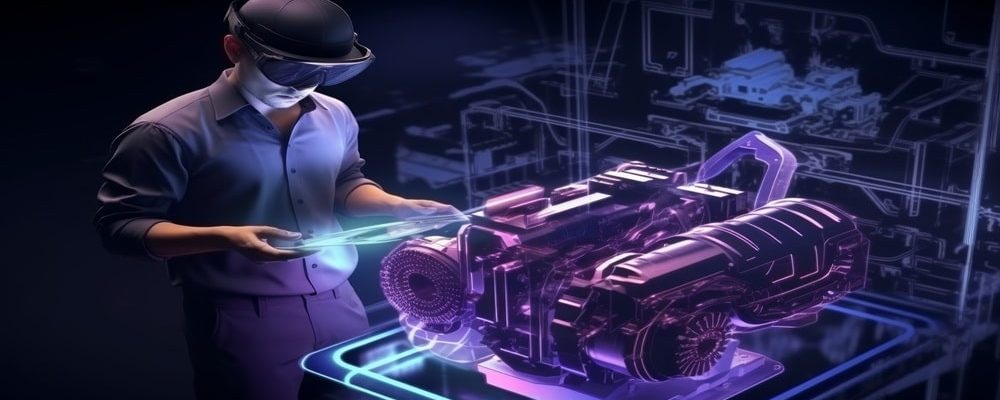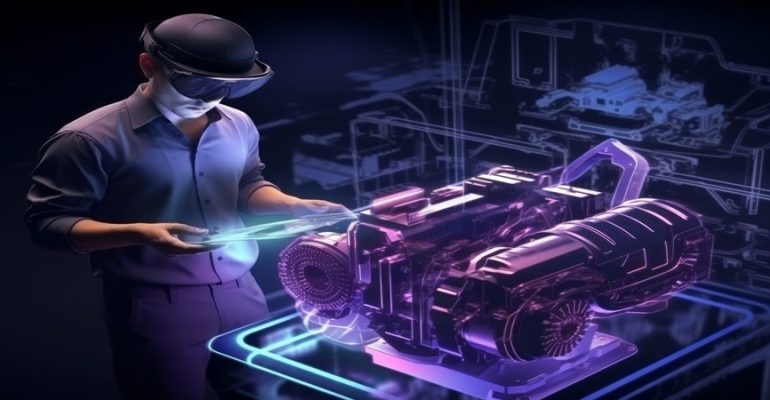
How XR is Powering Big Machinery for Manufacturing

How XR is Powering Big Machinery for Manufacturing
The manufacturing industry has always been at the forefront of innovation, adopting cutting-edge technologies to improve efficiency, productivity, and safety. In recent years, extended reality (XR), an umbrella term that includes Virtual Reality (VR), Augmented Reality (AR), and Mixed Reality (MR) has emerged as a game-changer in heavy machinery manufacturing. With industries becoming increasingly digital, XR is not just a futuristic concept; it is now a practical tool that is transforming how big machinery is designed, built, operated, and maintained.
In this blog, we will explore how XR is reshaping heavy industry and powering big machinery manufacturing across various stages of production, training, and maintenance.
Understanding XR in Heavy Machinery Manufacturing
Extended Reality brings together immersive technologies like virtual reality, augmented reality, and mixed reality to create experiences that bridge the physical and digital worlds. For heavy machinery manufacturing, where equipment is large, complex, and costly; XR provides a safer, faster, and more cost-efficient way to innovate.
- Virtual Reality (VR): Enables manufacturers to simulate big machinery designs, workflows, and environments without needing a physical prototype.
- Augmented Reality (AR): Overlays digital data, instructions, and models on real-world machinery for training, maintenance, and assembly.
- Mixed Reality (MR): Allows real-time interaction with 3D models of heavy machines, combining physical objects with digital visualizations.
By integrating these technologies, manufacturers can reduce errors, optimize processes, and ensure better collaboration across teams.
Why Heavy Industry Needs XR
Big machinery manufacturing comes with unique challenges. The equipment is enormous, expensive, and often operates in high-risk environments. Traditional methods of prototyping, training, and maintenance can be costly, time-consuming, and sometimes unsafe.
Key challenges XR addresses include:
- High costs of creating and testing physical prototypes.
- Risk of accidents during operator training.
- Communication barriers in global design teams.
- Difficulty in inspecting and maintaining massive machines in real-world environments.
- Unplanned downtime leading to huge financial losses.
XR solves these challenges by providing virtual environments, real-time collaboration, and immersive training simulations.
XR Use Cases in Big Machinery Manufacturing
- Virtual Prototyping and Product Design
Designing heavy machinery involves a lot of complexities. Traditional prototyping requires time, resources, and material costs. XR enables virtual prototyping, where engineers and designers can create and test 3D models of machinery before investing in physical versions.
With VR headsets, design teams can walk around a life-sized virtual model of a machine, analyze its structure, test functionalities, and make necessary adjustments. This not only reduces design errors but also significantly speeds up the product development lifecycle.
Benefits:
- Reduced time-to-market.
- Lower prototyping costs.
- Enhanced collaboration between design teams.
- Immersive Operator Training
Training operators to handle big machinery is often risky and resource intensive. XR provides a safe and immersive way to train operators using realistic virtual environments. Trainees can practice operating cranes, excavators, turbines, or other heavy machinery without risking accidents or damaging equipment.
For example, VR-based crane simulators allow operators to practice complex maneuvers, while AR headsets can guide workers in real-time by displaying operational steps directly on the machine.
Benefits:
- Safer training environments.
- Hands-on experience without physical risks.
- Increased operator confidence and efficiency.
- Maintenance and Repair Optimization
Downtime in heavy machinery can result in significant financial losses. XR plays a critical role in predictive and preventive maintenance. AR glasses, for instance, can overlay step-by-step repair instructions on real machinery, helping technicians perform maintenance with greater accuracy.
Additionally, digital twins—virtual replicas of physical machines—enable manufacturers to monitor equipment performance in real time. Using XR, technicians can identify issues before they lead to breakdowns, reducing downtime and repair costs.
Benefits:
- Faster problem diagnosis.
- Reduced downtime and costs.
- Enhanced technician performance with real-time guidance.
- Remote Collaboration and Inspections
In heavy machinery manufacturing, teams are often spread across different locations. XR makes remote collaboration seamless by enabling virtual meetings inside immersive 3D environments. Designers, engineers, and clients can view the same machine model, interact with it, and make real-time changes without traveling.
Similarly, remote inspections of large machines can be conducted using XR. AR glasses worn by on-site workers can stream live visuals to remote experts, who can provide instant guidance.
Benefits:
- Reduced travel expenses.
- Faster decision-making.
- Real-time collaboration across global teams.
- Safety and Risk Management
Heavy industry environments are inherently hazardous. XR allows manufacturers to create virtual simulations of risky scenarios, enabling workers to practice emergency procedures without any danger.
For instance, workers can simulate handling an equipment failure, fire outbreak, or other hazardous situations in a virtual space. This prepares them for real-world challenges and ensures safety compliance.
Benefits:
- Improved workplace safety.
- Risk-free practice of emergency protocols.
- Reduced workplace accidents.
The Role of Digital Twins in Heavy Machinery Manufacturing
One of the most powerful XR applications is the integration of digital twins; virtual replicas of physical assets. In big machinery manufacturing, digital twins combined with XR allow real-time monitoring of equipment, predictive maintenance, and better lifecycle management.
By using IoT sensors, manufacturers can track machinery performance and visualize data in an immersive environment. This leads to data-driven decision-making and significant cost savings.
The Business Impact of XR in Heavy Industry
Companies adopting XR in heavy machinery manufacturing are experiencing measurable benefits, including:
- Cost Savings: By eliminating physical prototypes and reducing downtime.
- Faster Innovation: Accelerated design-to-production cycles.
- Improved Training: Reduced accidents and higher workforce productivity.
- Global Collaboration: Smoother communication across international teams.
- Competitive Advantage: Staying ahead in the industry with cutting-edge technology adoption.
Real-World Examples of XR in Big Machinery Manufacturing
- Caterpillar: Uses AR-based applications for machine maintenance and operator training.
- Siemens: Incorporates XR with digital twins for predictive maintenance in heavy equipment.
- Komatsu: Implements VR for equipment operator training and safety simulations.
These examples highlight how XR is not just a concept but a practical solution delivering tangible results in the heavy machinery sector.
Challenges in Implementing XR
While XR offers enormous potential, there are challenges to overcome:
- Initial investment in XR hardware and software.
- Need for workforce upskilling to adapt to new technologies.
- Integration with legacy systems in manufacturing plants.
- Data privacy and cybersecurity concerns.
However, as technology advances and costs decline, these challenges are gradually being addressed.
The Future of XR in Heavy Machinery Manufacturing
The future of XR in big machinery manufacturing is bright. As industries continue to embrace Industry 4.0 and smart factories, XR will play a central role in:
- Fully immersive design and prototyping.
- AI-driven predictive maintenance through XR interfaces.
- Enhanced workforce training using gamified XR experiences.
- Seamless global collaboration in virtual factories.
With advancements in 5G connectivity, XR experiences will become more seamless and accessible, opening new opportunities for manufacturers worldwide.
Now Is the Time to Adopt XR in Heavy Machinery Manufacturing
The heavy industry sector is undergoing a digital transformation, and XR is at the core of this revolution. From virtual prototyping to immersive training, predictive maintenance, and global collaboration, XR is delivering unmatched value to manufacturers of big machinery.
Organizations that embrace XR today will not only reduce costs and improve efficiency but also position themselves as leaders in the future of industrial innovation.
The future of heavy industry is immersive, data-driven, safe and XR is the technology making it possible.